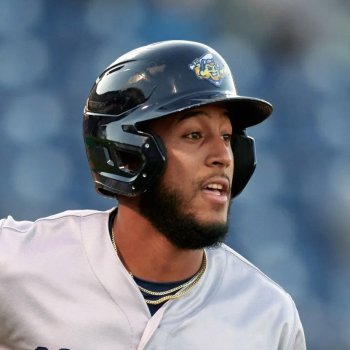
Twins Video
Since his arrival we have heard the tale of Neil Allen’s ability to convince the young pitchers to harness the power of the change-up. From 2009 to 2014, the Rays outpaced everyone by deploying the change-up 14.5% of the time. Naturally, the narrative would be that Allen would come to Minnesota and bestow the same secrets on the Twins’ pitching staff. But, in terms of sheer total percentage of pitches thrown, this has not happened. While the usage is up slightly for Minnesota from 2014, even when accounting for Mike Pelfrey and Ricky Nolasco’s splitter preference the Twins pitching staff still trails well behind the rest of the league in 2015.
So every other pitch is not a change-up. And pitchers like Phil Hughes have not greatly altered their pitch selections by learning a change-up. That said, the Twins have found great success on the occasions that they have used their change-ups this year.
In 2014, hitters had their way with the Twins’ change-up. Opponents hit .288 (29th out of 30) and posted a hefty 747 OPS. While the rest of the league’s pitchers kept hitters to a .234 average, Kevin Correia (.357), Tommy Milone (.341), Trevor May (.259) and Kyle Gibson (.244) all found themselves above that mark. While Correia was recently released by the Phillies, Milone (.241), May (.215) and Gibson (.179) have reconnected with the pitch this year, posting significantly improved averages against on change-ups. At a collective .207, they now hold the fifth-lowest average against on the change-up.
It was not just throwing more change-ups – it was using them under specific conditions.
“That’s the one thing me and Neil really talked about a lot and I really wanted to work on was executing change-ups to righties,” said Gibson this past March. “It’s a pitch that looks really similar to my sinker when I have the same release point I think it’s something that is really going to help my sinker against righties.”
Allen shared his theories and approach with the players in the spring. Everyone acknowledged they were on-board but no one with the Twins would divulge Allen’s secret recipe when it came to the change-up. From his perspective, when it came to the change-up catcher Kurt Suzuki said it is nice to have another finger to put down. Other pitchers echoed that mentality – the added bullet would be nice to have in the arsenal. Still, the chatter around the Twins camp was not that the change-up in and of itself was going to be the miracle out-pitch -- it was also going to set-up the miracle out-pitch.
****
The Rays have been long known to be a savvy, smarter-than-you organization. Their front office is basically a Harvard bar with equations on the wall and ****.
In The Extra 2%, baseball writer Jonah Keri documented how the organization’s analytics team running that ball club would stop at nothing to find any edge they could. Those findings were highlighted in obvious situations like the use of infield shifts or found when the Rays’ lineup would eschew the natural platoon advantage against pitchers who held quirky splits. The Wolves of Wall Street were now running a ball club with that same take-every-dollar attitude. They hired the sharpest minds and grabbed every scrap of data they could, compiled it into a proprietary database and studied it to ultimately move the needle to their advantage.
In the spreadsheets and on the field, the Rays found that the change-up was a highly underutilized weapon. Change-ups fell out of vogue in the modern world as teams craved fastball velocity and wicked benders to put away hitters. Meanwhile there was value to be had for the teams that creatively applied change-ups. While most organizations avoided throwing change-ups to same-sided hitters, the Rays mandated it.
“We’ve got a process that, when you hit Double-A, you’ve got to be able to throw your change-up to righties and left-handers, no matter what side you throw from,” Allen, then with the Rays organization, told Baseball Prospectus. “It’s become a weapon that we started a few years ago. There were a lot of guys coming to Triple-A that couldn’t throw their change-up for strikes righty-on-lefty or lefty-on-righty. The change is a great pitch if you utilize it [well], but we started getting into the philosophy that if it works opposite arm to opposite hitter, why don’t we start trying it righty-on-righty and lefty-on-lefty.”
In the majors, the Rays paced the game with far more same-sided change-ups than the rest of the league -- but mainly in righty-to-righty situations. From 2009 to 2014, as the Minnesota Twins’ right-handed pitchers threw change-ups to right-handed hitters 5.3% of the mix, the Rays threw it a whopping 12.6% of their mix. Perhaps as a result, right-handed pitchers for the Rays held the right-handed hitters to a .243 average while the Twins finished last in that category with a .279 average.
Since Allen’s hiring, the Twins have followed a similar pattern. Gibson has increased his usage of the change-up overall (from 12% to 17%) and much of that has come against right-handed hitters. In 2014, he threw the pitch to the same-side 1.5% of the time but uses it 14% of the time this year. Trevor May has thrown his change more to righties as well (from 9.9% to 13.2%). Milone, on the other hand, has thrown the pitch less against lefties this year than he has in the past. Despite flashing a solid change-up to David Ortiz in spring training, Milone has abandoned that pitch in favor of a cutter. The Rays southpaws were hesitant to throw the pitch to other lefties as well -- Rays lefty Matt Moore cited the left-handed hitter’s natural low swing plane as a deterrent to throwing to the same-side.
What the Rays discovered is that not only is the change-up effective in same-sided circumstances, but the change-up is also potent when thrown consecutively. From 2009 to 2014, the Rays threw the most change-ups but they also threw the highest number of change-ups after change-ups. And when the Rays pitchers doubled up on change-ups -- which they did a MLB-high 32% of the time -- they held opponents to a .189 batting average against.
The Rays stacked change-ups like no other team. But the idea wasn’t just to throw out two change-ups in a row. The idea was to hammer the bottom of the zone.
****
In addition to the same-sided usage, the strategic sequencing with the change-up has played a significant role in Twins’ pitchers abilities to generate outs.
“I know that he’s a little bit analytical but not really but the stuff that he tells me that I see from an analytical side and it’s stuff that makes a lot of sense,” Twins closer Glen Perkins said about his new pitching coach and the emphasis on the change-up this spring. “I talk to hitters when we are playing cards after the game or standing in the dugout or whatever and the kinda things they are thinking.... [Allen’s] thinking from a hitter’s perspective on it.”
Although he personally doesn’t throw a change-up, he toys with it during warm-ups and thinks about having it ready in the event that his devastating fastball-slider combo ever fails him. Perkins, an analytical mind on the mound, was intrigued by Allen’s sales pitch on the chang-eup.
The discussions in the clubhouse, in team meetings and during bullpen sessions are well and good, though applying the ideas into game situations can be tricky.
In Tuesday night’s game against the Orioles, Gibson recorded three outs on the change-up, including a strikeout in the third of the right-handed Adam Jones. While that may have been just a line of code in the PitchF/X system, the righty-on-righty success was a noteworthy milestone to Gibson. In 2014, Gibson was attempting to incorporate more change-ups against righties when he found himself tangling with Jones in Baltimore. Jones timed a change-up to perfection and launched a long home run. That encounter, Gibson admitted, reduced his confidence in turning to the pitch against righties. But over the offseason and into the spring, Allen provided support for Gibson and pushed him to use the pitch more to righties.
While the change-up led to three outs, Gibson also recorded six outs on the pitch after a changeup -- weak contact induced by throwing a follow-up pitch down in the zone. This has been what the Twins pitchers -- particularly Gibson, May and Milone -- have succeeded at all year. If the change-up fails to record an out, they have returned to the bottom of the zone with another pitch.
Guys like Gibson and Milone have become out generators because they have followed this pattern and it is making their other pitches better. Allen’s guidance to Gibson was to throw his change-up more in circumstances when he would normally throw his slider. While Gibson’s change-up has had great success on its own, it has enhanced his slider’s performance as well, reducing his average against from .210 to .167 while increasing his swinging strikes on the pitch. For Milone, he has kept hitters off his fastball – posting a career-low .248 average against. Similarly, May’s fastball average against has gone from .333 to .287.
Weaker contact has resulted in more outs, fewer base-runners and fewer runs.
MORE FROM TWINS DAILY
— Latest Twins coverage from our writers
— Recent Twins discussion in our forums
— Follow Twins Daily via Twitter, Facebook or email
— Become a Twins Daily Caretaker







Recommended Comments
Join the conversation
You can post now and register later. If you have an account, sign in now to post with your account.
Note: Your post will require moderator approval before it will be visible.